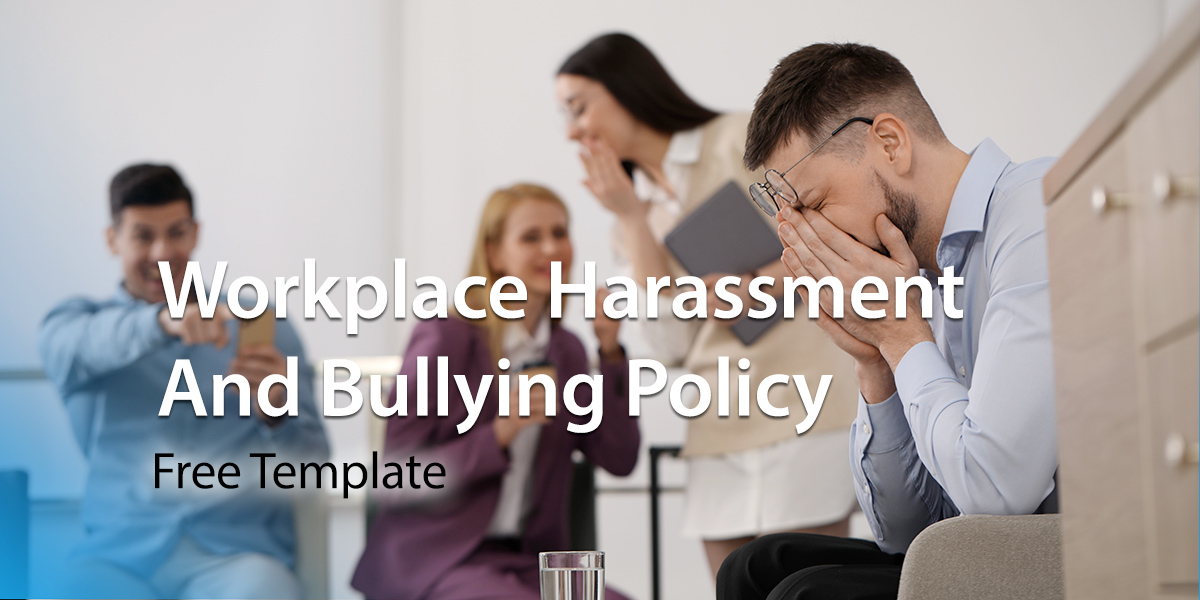Dubbed an office cancer by some commentators, workplace harassment and bullying are on the rise. According to one global survey, almost 23 percent of workers have experienced harassment and violence. And the impacts on staff and organizations are extensive and wide ranging. Many workers suffer physical injuries and are unable to work. It also affects mental wellbeing, with depression, anxiety, and stress severely affecting an individual’s work performance. And for the organization, high absenteeism, skyrocketing employer turnover, and low productivity are the fallout. Some employers even find themselves facing lawsuits and workers’ compensation claims. Furthermore, a hostile work environment kills morale for everyone.
Employees should feel safe and secure while at work. Stamping out harassment and bullying is the duty of every responsible employer. And there’s no better place to start than with a workplace harassment policy.
An organization-wide policy makes crystal clear your commitment to tackling workplace bullying and harassment. Employees are encouraged to come forward and report harassing behavior. And they can feel confident their complaints will be taken seriously and action taken.
Our free workplace harassment policy template reflects the latest best practices. Use it to start the ball rolling in your organization and adapt it to suit your circumstances.
Before we dive into the template, let’s be clear about what workplace harassment and bullying are all about.
What Is Workplace Bullying?
Workplace bullying refers to repeated and persistent negative behavior in a work environment where one or more individuals are subjected to intentional harm, mistreatment, or harassment by their colleagues, direct supervisor, managers, or independent contractors. It can take many forms, including the following:
- Repeated and Persistent: Workplace bullying typically involves ongoing patterns of behavior rather than a single incident. It occurs over a prolonged period, often with a consistent target.
- Abuse of Power: Bullying often stems from an imbalance of power, where the bully holds a higher position or has some control over the target. This power imbalance allows the bully to intimidate, threaten, or demean the target.
- Verbal Abuse: This can include shouting, belittling, humiliating, or using offensive language toward the target. It may involve spreading rumors, derogatory comments, or undermining the target’s abilities.
- Physical Intimidation: Physical bullying involves threats or aggression, such as pushing, hitting, or damaging personal belongings. Although less common in the workplace, it can still occur.
- Exclusion and Isolation: Bullies may intentionally isolate their targets, exclude them from team activities or important meetings, or create a hostile work environment where the target feels like an outcast.
- Cyberbullying: With increased remote working and digital communication, workplace bullying can also occur online. It may involve sending abusive emails, spreading harmful rumors, or using social media to harass or demean the employee.
- Undermining and Sabotage: Bullies may deliberately undermine the target’s work by withholding necessary information, not providing support or resources, or intentionally setting them up for failure.
What Is Workplace Harassment?
Workplace harassment is any unwanted or offensive behavior directed towards an employee or group of employees based on protected characteristics such as race, gender, religion, nationality, age, disability, or sexual orientation.
Harassing conduct typically comes under two main categories:
- Sexual Harassment: This type of harassment involves unwelcome sexual advances, requests for sexual favors, or other verbal, non-verbal, or physical conduct of a sexual nature.
- Discriminatory Harassment: Harassing conduct occurs when an employee is targeted based on race, ethnicity, religion, gender, gender identity, marital status, age, or disability. It can include offensive name-calling, slurs, derogatory jokes, or actions that demean a worker based on these characteristics.
It’s important to note that discrimination and sexual harassment are illegal in many jurisdictions and are a violation of federal and state laws. Employers are responsible for maintaining a safe and respectful work environment, And they may be liable for any harassment within their organization.
How Do You Write A Harassment Policy?
Starting with a blank piece of paper is always a challenge. However, breaking the task into bite-sized chunks makes even the complex more manageable. Here are the steps you need to take to create a harassment policy in your organization:
1. Policy Statement
Begin by clearly stating the purpose of the policy. Emphasize the organization’s commitment to maintaining a work environment free from bullying and harassment. Furthermore, outline the importance of fostering respect, dignity, and equality among employees.
2. Definitions
Provide clear definitions of bullying and harassment according to legal standards and your organization’s values. Include examples of such behavior to help employees understand what is unacceptable.
3. Scope
Clearly state to which personnel the harassment policy applies. It could be all employees and non-employees, such as contractors and volunteers. Also, be explicit about the context. Best practices suggest the policy should apply onsite, off-site, and online. Make it clear that the policy covers all forms of bullying and harassment.
4. Responsibilities
Outline the duties of various parties within the organization, such as management, supervisors, HR personnel, and employees, in preventing and addressing bullying and harassment. Emphasize that everyone is responsible for reporting incidents. And ensure workers who experience or witness incidents are encouraged to come forward.
5. Reporting Mechanisms
Describe the reporting procedures for employees to report harassment. Include multiple options, such as a complaint to managers, human resources (HR) representatives, or an anonymous system. Assure employees that reports will be treated confidentially and that there will be no retaliation for making a good-faith report.
6. Investigation and Resolution Process
Detail how the organization will handle reports of bullying, harassment, and workplace discrimination. Include information about the investigation process, timelines, the impartiality of investigators, and potential measures, including disciplinary action. Provide advice and support to persons involved who may want to pursue legal remedies.
7. Support and Resources
Provide information about the support mechanisms available to employees with a complaint about bullying and harassment. Possibilities include counseling services, employee assistance programs, or external resources. Encourage employees to seek support and provide contact information for relevant agencies.
8. Training and Awareness
Highlight the organization’s commitment to ongoing training and awareness programs on bullying and harassment. State that employees will receive regular training on their rights, responsibilities, and the expectations outlined in the policy.
9. Consequences
Detail the potential consequences for any person found responsible for bullying or harassment. These may include legal remedies and disciplinary actions, including termination of employment. Make it clear that such behavior will not be tolerated.
10. Policy Review
Indicate that the policy will be reviewed to ensure its effectiveness and compliance with changing laws and regulations. Specify who is responsible for the policy’s review and how updates or revisions will be shared with employees.
Remember to consult with legal professionals or human resource experts to ensure your policy complies with relevant laws and regulations. Tailor the policy to fit your organization’s specific needs and culture. And ensure it is accessible and effectively communicated to all staff.
Free Workplace Harassment And Bullying Policy Template
Policy Brief & Purpose
Our workplace harassment and bullying policy details our commitment to maintaining a respectful and inclusive workplace free from harassment or bullying. This policy applies to all employees, contractors, and non-employees, such as public visitors, customers, and other work contacts. By implementing this policy, we aim to ensure our staff members’ safety, wellbeing, and productivity.
Scope
This policy applies to all individuals within our organization, including workers at every level, contractors, temporary staff, interns, and volunteers. It also extends to external parties such as clients, customers, suppliers, and visitors who come into contact with our employees in any work-related context.
Policy Elements
The definition of workplace harassment includes any unwelcome or offensive conduct, whether verbal, non-verbal, or physical, that creates a hostile or offensive team environment. This can encompass a wide range of behaviors, including but not limited to:
- Bullying: Persistent and targeted mistreatment, humiliation, or intimidation of an individual by one or more persons
- Intimidation: Acts or statements intended to create fear, distress, or harm
- Direct Insults: Derogatory or offensive remarks targeting an individual’s personal attributes, sex, characteristics, or performance
- Sexual Harassment: Examples include inappropriate touching, requests for sexual favors, sexually-orientated jokes or comments, and sexual assault
- Malicious Gossip: Spreading harmful or false information about a worker to damage their reputation
- Victimization: Unfair or prejudiced treatment of a worker based on personal characteristics, sex, or circumstances
Examples Of Harassing Conduct
While it is impossible to provide an exhaustive list, here are some examples of behaviors that may constitute harassment or discrimination:
- Sabotaging someone’s work intentionally
- Engaging in sexual harassment with frequent or unwanted advances, or unwelcome conduct of a sexual nature
- Commenting derogatorily on a person’s age, sexual orientation, sex, national origin, race, religion, disability, or other protected characteristics
- Starting or spreading rumors about an employee’s personal life or engaging in gossip that harms their reputation
- Ridiculing a person in front of others or singling them out for demeaning tasks unrelated to their job against their will
Reporting Such Conduct
If you are a victim or witness of harassment or bullying, it is essential to take the following steps:
-
Report the incident to your immediate supervisor, manager, or another trusted person in authority
-
If your complaint involves your supervisor or manager, or if you are uncomfortable reporting to them, talk directly to HR
-
Maintain a record of the incidents, including dates, times, locations, and descriptions of the events
-
Cooperate fully in any investigation carried out by the company
Managers and HR personnel have a responsibility to:
- Take all reports seriously and conduct a prompt and impartial investigation
- Maintain confidentiality to the extent possible while conducting investigations
- Provide appropriate support to the employee and ensure they are protected from retaliation
- Take necessary corrective action to address and resolve any complaint
Disciplinary Consequences
The disciplinary consequences for harassment and bullying will depend on the severity of the offense, following a fair and thorough investigation. Action may include, but is not limited to:
- Counseling or mediation to address the issue and prevent further incidents
- Verbal or written reprimands
- Temporary or permanent transfer to a different department or location
- Suspension without pay
- Termination of an individual’s employment or contractual relationship
Our organization reserves the right to take other legal action in relation to complaints involving non-employees.
Policy Review
The HR manager is responsible for annual policy reviews and reporting on the outcomes to the senior leadership. Employees will be advised of changes through the intranet, employee newsletter, and other communication channels.
Disclaimer: This policy template is meant to provide general guidelines and should be used as a reference. It may not consider all relevant local, state, or federal laws and is not a legal document. MyHub Intranet Solutions will not assume any legal liability for using this policy.
PDF Download: Workplace Harassment And Bullying Policy PDF
Word Document Download: Workplace Harassment And Bullying Policy Word Document
Workplace Harassment Policy: Useful Resources
Here are some additional resources to support you in developing a policy:
- Sexual Harassment (Equal Employment Opportunity Commission)
- Harassment (Equal Employment Opportunity Commission)
- Protections Against Discrimination and Other Prohibited Practices (Federal Trade Commission)
- How Bullying Manifests at Work — and How to Stop It (Harvard Business Review)
About MyHub
MyHub is a leading provider of cloud intranet solutions. Our easy-to-use software powers the digital workplace in organizations across the globe. Find out more with a free demo or 14-day trial. And sign up for our insightful blog for more analysis on today’s hot issues.










0 Comments